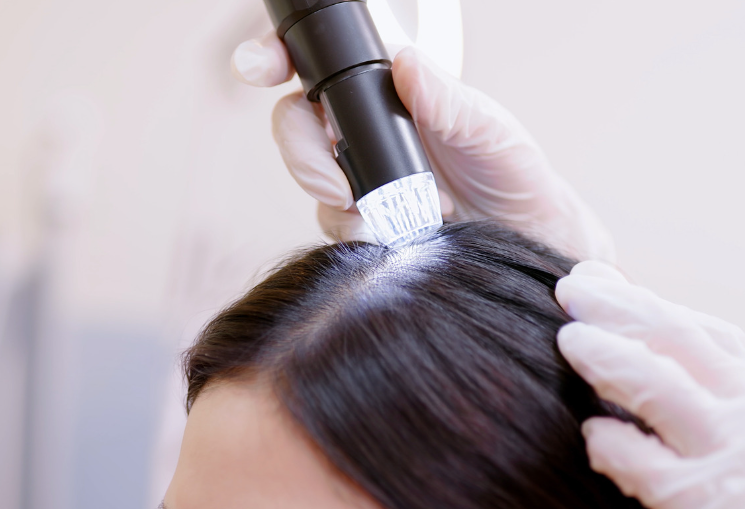Health Conditions
What Skin Cancer on Your Scalp REALLY Looks Like
Understanding the appearance of skin cancer lesions on the scalp, from unusual growths to changes in existing moles or spots, can empower individuals to monitor their scalp health effectively.
Skin cancer can manifest anywhere on the body, including the scalp, yet detecting it in this area can be challenging due to the presence of hair. Despite the concealment, recognizing the signs of skin cancer is crucial for early detection and timely intervention.
Skin cancer is a serious concern, and understanding what it looks like on the scalp can be crucial for early detection. The scalp is often exposed to the sun, making it a vulnerable area for skin cancer to develop. In this article, we will explore what skin cancer on the scalp looks like, the signs and symptoms to watch out for, and the importance of regular self-examinations.
Types of Skin Cancer that can Occur on the Scalp
Skin cancer on the scalp can take various forms. The most frequent types of skin cancer that can develop on the scalp are basal cell carcinoma (BCC), squamous cell carcinoma (SCC), and melanoma. BCC is the most common kind, and it usually shows as a raised, white lump with visible blood vessels.
SCC, on the other hand, usually manifests itself as a scaly or crusty patch of skin that does not heal. Melanoma, the most deadly form of skin cancer, can develop anywhere on the body, including the scalp. It usually appears as an irregularly shaped mole that might be black, brown, pink, or red.

Signs and Symptoms of Skin Cancer on the Scalp
Skin cancer on the scalp can cause a variety of symptoms. It could start as a new growth or a changing mole on the scalp. These growths may be solid, elevated, or flat. They may also have an uneven surface, irregular borders, or many colors inside the same lesion.
Furthermore, skin cancer on the scalp might manifest as a scaly patch that lasts for weeks or months without healing. It may also cause itching, discomfort, or bleeding. Other symptoms may include an unhealed sore, a mass beneath the skin, or persistent irritation or pain.
Risk Factors for Developing Skin Cancer on the Scalp
Several risk factors contribute to the development of scalp skin cancer. The greatest risk factor is prolonged exposure to ultraviolet (UV) light from the sun or tanning beds. Fair-skinned people are especially vulnerable to the damaging effects of UV light.
Other risk factors include a history of sunburns, a family history of skin cancer, a weaker immune system, exposure to specific chemicals or radiation, and a personal experience of skin cancer. It is critical to be aware of these risk factors and take the required steps to protect the scalp from sun damage.

Importance of Early Detection and Prevention
Skin cancer on the scalp is best managed by early detection and prevention. Regular self-examinations and visits to the dermatologist are vital for detecting skin cancer in its early stages. Early detection of skin cancer considerably improves treatment outcomes and minimizes the risk of complications.
It is critical to take proactive steps to protect the scalp from sun damage, such as wearing protective clothing and using high-SPF sunscreen on a regular basis. Additionally, seek shelter when the sun’s rays are at their highest, which is normally between 10 a.m. and 4 p.m.
How to Perform a Self-Examination for Scalp Skin Cancer
Conducting self-examinations for scalp skin cancer can aid in early detection. Begin by studying your scalp in a well-lit room with a mirror. Part the hair into parts for a thorough examination. Look for changes in moles, new growths, or strange skin patches.
Pay close attention to the size, shape, color, and texture of any irregularities. If you observe any significant changes or abnormalities, you should see a dermatologist for a proper diagnosis. Remember to conduct regular self-examinations to track any changes over time.
Treatment Options for Skin Cancer on the Scalp
The type and stage of skin cancer on the scalp determine the available treatment choices. The most popular treatment options are surgical removal, radiation therapy, and topical therapies. Surgical removal entails removing both the malignant tumor and a margin of healthy tissue.
In some circumstances, Mohs surgery may be necessary to guarantee full eradication while conserving as much healthy tissue as possible. Radiation therapy can be used as a standalone treatment or in conjunction with surgery to eliminate cancer cells. Creams or gels may be used to treat superficial skin malignancies.

Recovery and Aftercare for Scalp Skin Cancer Patients
Recovery and aftercare are critical components in the treatment of scalp skin cancer. After any surgical treatment, it is critical to maintain the postoperative site clean and dry. Your dermatologist will provide specific wound care recommendations, such as how to clean the area and when to remove bandages or stitches.
It is critical to protect the scalp from future sun damage by wearing a hat or applying sunscreen. Regular follow-up appointments will be organized to monitor the healing process and prevent recurrence.
Tips for Protecting the Scalp from Sun Damage
Protecting the scalp from UV damage is critical in preventing cancer. Wearing a wide-brimmed hat that shades the face, neck, and scalp is strongly advised. Choose hats with a UPF (ultraviolet protection factor) rating to provide extra sun protection.
Apply high-SPF sunscreen to exposed regions of the scalp, reapplying every two hours or after sweating or swimming. Seek shade wherever feasible, particularly during high sunlight hours. Remember that UV radiation can pass through clouds and glass, so take measures even on cloudy days or indoors near windows.
Conclusion
Finally, knowing the signs and symptoms of skin cancer on the scalp is critical for early detection and treatment. Regular self-examinations, together with professional skin checks, are critical for detecting any worrying changes or anomalies.
Wearing protective gear and sunscreen can help minimize the chance of getting scalp skin cancer. Stay cautious and informed, as early discovery greatly enhances the likelihood of successful treatment. Schedule regular check-ups with a dermatologist to ensure your scalp’s health and overall well-being.
Remember that your scalp requires just as much care and attention as the rest of your body. Do not ignore it, and take proactive measures to shield it from the sun’s harmful effects. Stay aware, diligent, and prioritize your scalp’s health.
Trusted Health, Wellness, and Medical advice for your well-being



